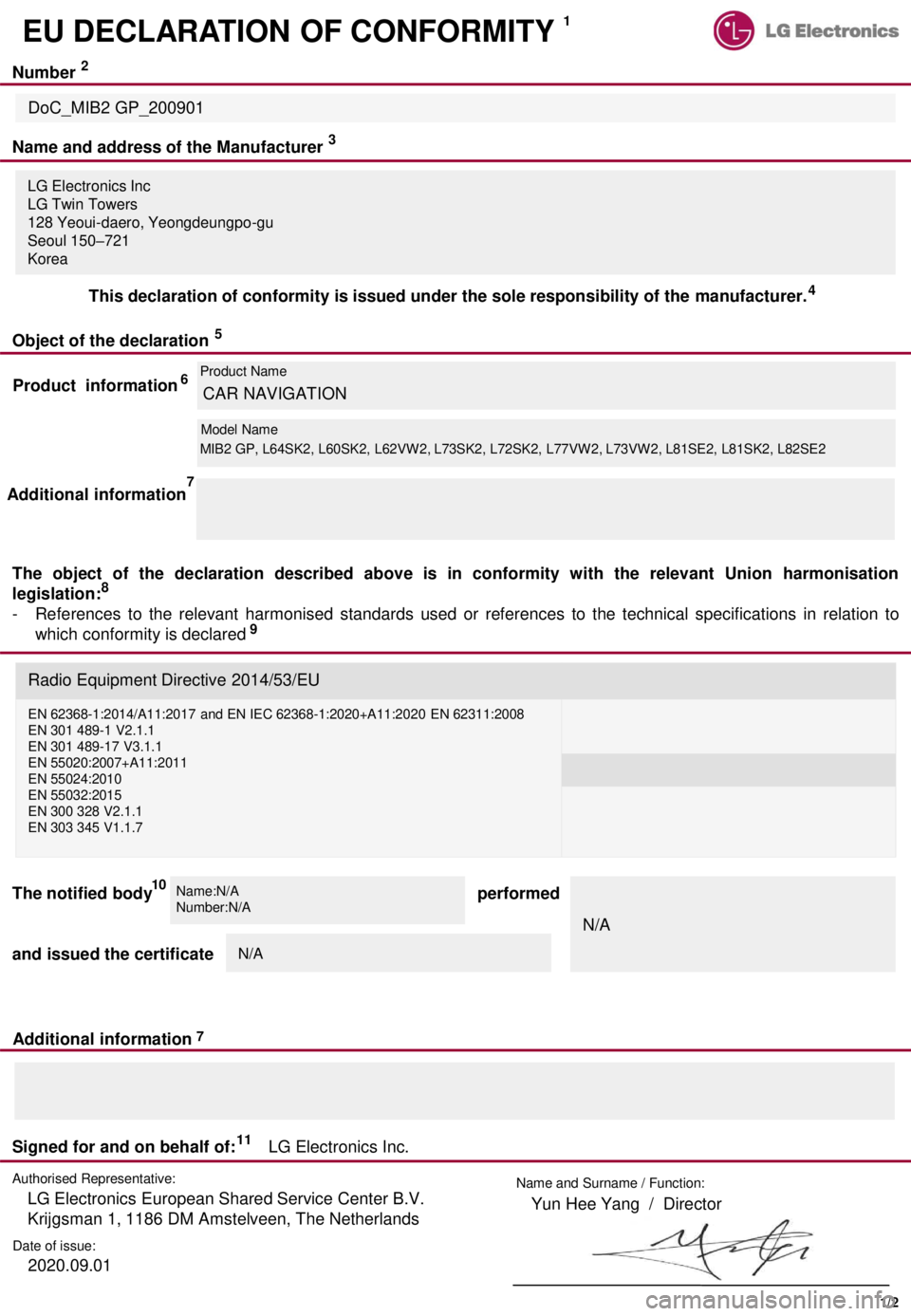radio Seat Ibiza 2020 Directive 2014/53/EU Bluetooth
[x] Cancel search | Manufacturer: SEAT, Model Year: 2020, Model line: Ibiza, Model: Seat Ibiza 2020Pages: 406, PDF Size: 9.22 MB
Page 1 of 406

Name and address of the Manufacturer
Name and Surname / Function:
LG Electronics European Shared Service Center B.V.
Krijgsman 1, 1186 DM Amstelveen, The Netherlands Yun Hee Yang / Director EU DECLARATION OF CONFORMITY
Object of the declarationNumber
DoC_MIB2 GP_200901
This declaration of conformity is issued under the sole responsibility of the manufacturer.
The object of the declaration described above is in conformity with the relevant Union harmonisation
legislation :
- References to the relevant harmonised standards used or references to the technical specifications in relation to
which conformity is declared
Signed for and on behalf of: LG Electronics Inc.
Authorised Representative:
2020.09.01Date of issue: 1
2
3
4
5
8
9
11
1/2LG Electronics Inc
LG Twin Towers
128 Yeoui - daero , Yeongdeungpo - gu
Seoul 150 – 721
Korea
Additional information 7Product information Product Name
Model Name CAR NAVIGATION
MIB2 GP, L64SK2, L60SK2, L62VW2, L73SK2, L72SK2, L77VW2, L73VW2, L81SE2, L81SK2, L82SE2
Additional information 6
10
The notified body performed
and issued the certificate N/AName:N /A
Number:N /A
N/ARadio Equipment Directive 2014/53/EU
EN 62368 - 1:2014/A11:2017 and EN IEC 62368 - 1:2020+A11:2020 EN 62311:2008
EN 301 489 - 1 V2.1.1
EN 301 489 - 17 V3.1.1
EN 55020:2007+A11:2011
EN 55024:2010
EN 55032:2015
EN 300 328 V2.1.1
EN 303 345 V1.1.7 7
Page 16 of 406

Page 11 of 90 Report No. : 60404487 001
TR F No. IEC62368_1 C
General product information and other remarks:
This product(CAR AUDIO) is a building - in type as component which has Bluetooth, Radio and DAB
functions.
It is Class III equipment supplied by a 12 V EV b attery.
It is intended to be built in a vehicle by an instructed person or skilled person as service person and user’s
manual shall be provided in the end equipment.
The Model L60SK2 is basic model and the model MIB2GP is identical to the basic model excep t for model
designation .
The models L81SK2, L73SK2 and L72SK2 are similar to the basic model except for model designation and
front enclosure design. It doe s not affect to safety factor.
The maximum ambient temperature permitted by the manufacturer (Tma): 85 o
C
This report is for standard up - date from IEC 60065:2014 to IEC 62368 - 1:2018 by earlier test report No.
50040903 001, 50040903 002, 50040903 003, 50040903 004 and 50040903 005 with the certificate
No. JPTUV - 071619, JPTUV - 071619 - A1, JPTUV - 071619 - A1/M1 , JPTUV - 071619 - A2/M1 and
JPTUV - 071619 - A2/M2.
The samples submitted for evaluation are representative of the final product and have the same quality in
items of safety aspect from each factory.
When installing, all the requirements of IEC 62368 - 1 must be f ulfilled.
Page 66 of 406

Page 61 of 90 Report No. : 60404487 001
IEC 62368 - 1 – ATTACHMENT 1
Clause Requirement + Test Result - Remark Verdict
TR F No. IEC62368_1 C
10.5.1 Add the following after the first paragraph:
For RS 1 compliance is checked by measurement
under the following conditions:
In addition to the normal operating condi tions, all
controls adjustable from the outside by hand, by any
object such as a tool or a coin, and those internal
adjustments or presets which are not locked in a reliable
manner, are adjusted so as to give maximum radiation
whilst maintaining an intelli gible picture for 1 h, at the
end of which the measurement is made.
NOTE Z1 Soldered joints and paint lockings are examples of
adequate locking.
The dose - rate is determined by means of a radiation
monitor with an effective area of 10 cm², at any point 10
cm from the outer surface of the apparatus.
Moreover, the measurement shall be made under fault
conditions causing an increase of the high - voltage,
provided an intelligible picture is maintained for 1 h, at
the end of which the measurement is made.
For RS 1, the dose - rate shall not exceed 1 μSv/h taking
account of the background level.
NOTE Z2 These values appear in Directive 96/29/Euratom of 13 May
1996. N/A
10.6.1 Add the following paragraph to the end of the
subclause:
EN 71 - 1:2011, 4.20 and the relat ed tests methods and
measurement distances apply. N/A
10.Z1 Add the following new subclause after 10.6.5.
10.Z1 Non - ionizing radiation from radio frequencies
in the range 0 to 300 GHz
The amount of non - ionizing radiation is regulated by
European Council Recommendation 1999/519/EC of 12
July 1999 on the limitation of exposure of the general
public to electromagnetic fields (0 Hz to 300 GHz).
For intentional radiators, ICNIRP guidelines should be
taken into account for Limiting Exposure to Time -
Varying Elec tric, Magnetic, and Electromagnetic Fields
(up to 300 GHz). For hand - held and body - mounted
devices, attention is drawn to EN 50360 and EN 50566 N/A
G.7.1 Add the following note:
NOTE Z1 The harmonized code designations corresponding to the
IEC cord type s are given in Annex ZD. P
Page 77 of 406

Page 72 of 90 Report No. : 60404487 001
IEC 62368 - 1_ATTACHMENT 2
Clause Requirement + Test Result - Remark Verdict
TR F No. IEC62368_1 C
– uses a listening device, such as headphones or
earphones that can be worn in or on or
around the ears; and
– has a player that can be body worn (of a size
suitable to be carried in a clothing pocket) and
i s intended for the user to walk around with while in
continuous use (for example, on a street,
in a subway, at an airport, etc.).
EXAMPLES Portable CD players, MP3 audio players, mobile
phones with MP3 type features, PDAs or similar equipment.
Personal m usic players shall comply with the
requirements of either 10.6.2 or 10.6.3.
NOTE 1 Protection against acoustic energy sources from telecom
applications is referenced to ITU - T P.360.
NOTE 2 It is the intention of the Committee to allow the
alternative met hods for now, but to only use the dose
measurement method as given in 10.6.5 in future. Therefore,
manufacturers are encouraged to implement 10.6.5 as soon as
possible.
Listening devices sold separately shall comply with
the requirements of 10.6.6.
These requirements are valid for music or video
mode only.
The requirements do not apply to:
– professional equipment;
NOTE 3 Professional equipment is equipment sold through
special sales channels. All products sold through
normal electronics stores are consid ered not to be professional
equipment.
– hearing aid equipment and other devices for
assistive listening;
– the following type of analogue personal music
players:
• long distance radio receiver (for example, a
multiband radio receiver or world band radio
receiver, an AM radio receiver), and
• cassette player/recorder;
NOTE 4 This exemption has been allowed because this
technology is falling out of use and it is expected that
within a few years it will no longer exist. This exemption will not
be extended t o other technologies.
– a player while connected to an external amplifier
that does not allow the user to walk around
while in use.
For equipment that is clearly designed or intended
primarily for use by children, the limits of the
relevant toy standards may apply.
The relevant requirements are given in
Page 78 of 406

Page 73 of 90 Report No. : 60404487 001
IEC 62368 - 1_ATTACHMENT 2
Clause Requirement + Test Result - Remark Verdict
TR F No. IEC62368_1 C
EN 71 - 1:2011, 4.20 and the related tests methods
and measurement distances apply.
10.6.1.2 Non - ionizing radiation from radio frequencies in
the range 0 to 300 GHz
The amount of non - ionizing radiat ion is regulated by
European Council Recommendation 1999/519/EC of
12 July 1999 on the limitation of exposure of the
general public to electromagnetic fields (0 Hz to 300
GHz).
For intentional radiators, ICNIRP guidelines should
be taken into account for L imiting Exposure to Time -
Varying Electric, Magnetic, and Electromagnetic
Fields (up to 300 GHz). For hand - held and body
mounted devices, attention is drawn to EN 50360
and EN 50566. N/A
10.6.2 Classification of devices without the capacity to estimate so und dose
N/A
10.6.2.1 General
This standard is transitioning from short - term based
(30 s) requirements to long - term based (40 hour)
requirements. These clauses remain in effect only
for devices that do not comply with sound dose
estimation as stipulated in EN 50332 - 3.
For classifying the acoustic output L Aeq , T ,
measurements are based on the A - weighted
equivalent sound pressure level over a 30 s period.
For music where the average sound pressure (long
term L Aeq , T ) measured over the duration of the song
is lower than the average produced by the
programme simulation noise, measurements may be
done over the duration of the complete song. In this
case, T becomes the duration of the song.
NOTE Classical music, acoustic music and broadcast typically
has an av erage sound pressure (long term L Aeq , T ) which is much
lower than the average programme simulation noise. Therefore, if
the player is capable to analyse the content and compare it with
the programme simulation noise, the warning does not need to be
given as long as the average sound pressure of the song does
not exceed the required limit.
For example, if the player is set with the programme simulation
noise to 85 dB, but the average music level of the song is only 65
dB, there is no need to give a warning or ask an
acknowledgement as long as the average sound level of the song
is not above the basic limit of 85 dB. N/A
10.6.2.2 RS1 limits (to be superseded, see 10.6.3.2)
RS1 is a class 1 acoustic energy source that does
not exceed the following:
– for equi pment provided as a package (player with
its listening device), and with a proprietary connector
between the player and its listening device, or where N/A
Page 120 of 406

Page 10 of 89 Report No. : 60404488 001
TR F No. IEC62368_1 C
General product information and other remarks:
This product(CAR AUDIO) is a building - in type as component which has Bluetooth, Radio and DAB
functions.
It is Class III equipment supplied by a 12 V EV b attery.
It is intended to be built in a vehicle by an instructed person or skilled person as service person and user’s
manual shall be provided in the end equipment.
The Model L60 VW 2 is basic model and the model MIB2GP is identical to the basic model excep t for model
designation .
The models L73VW2 and L77VW2 are similar to the basic model except for model designation and
mechanical frame . It does not affect to safety factor.
The maximum ambient temperature permitted by the manufacturer (Tma): 85 o
C
This rep ort is for standard up - date from IEC 60065:2014 to IEC 62368 - 1:2018 by earlier test report No.
50040904 001, 50040904 002, 50040904 003 and 50040904 004 with the certificate No. JPTUV - 071621,
JPTUV - 071621 - A1, JPTUV - 071621 - A1/M1 and JPTUV - 071621 - A1/M2 .
The samples submitted for evaluation are representative of the final product and have the same quality in
items of safety aspect from each factory.
When installing, all the requirements of IEC 62368 - 1 must be fulfilled.
Page 170 of 406

Page 60 of 89 Report No. : 60404488 001
IEC 62368 - 1 – ATTACHMENT 1
Clause Requirement + Test Result - Remark Verdict
TR F No. IEC62368_1 C
10.5.1 Add the following after the first paragraph:
For RS 1 compliance is checked by measurement
under the following conditions:
In addition to the normal operating conditions, all
controls adjustable from the outside by hand , by any
object such as a tool or a coin, and those internal
adjustments or presets which are not locked in a reliable
manner, are adjusted so as to give maximum radiation
whilst maintaining an intelligible picture for 1 h, at the
end of which the measurem ent is made.
NOTE Z1 Soldered joints and paint lockings are examples of
adequate locking.
The dose - rate is determined by means of a radiation
monitor with an effective area of 10 cm², at any point 10
cm from the outer surface of the apparatus.
Moreover, the measurement shall be made under fault
conditions causing an increase of the high - voltage,
provided an intelligible picture is maintained for 1 h, at
the end of which the measurement is made.
For RS1, the do se - rate shall not exceed 1 μSv/h taking
account of the background level.
NOTE Z2 These values appear in Directive 96/29/Euratom of 13 May
1996. N/A
10.6.1 Add the following paragraph to the end of the
subclause:
EN 71 - 1:2011, 4.20 and the related tests methods and
measurement distances apply. N/A
10.Z1 Add the following new subclause after 10.6.5.
10.Z1 Non - ionizing radiation from radio frequencies
in the range 0 to 300 GHz
The amount of non - ionizing radiation is regulated by
European Council Recommend ation 1999/519/EC of 12
July 1999 on the limitation of exposure of the general
public to electromagnetic fields (0 Hz to 300 GHz).
For intentional radiators, ICNIRP guidelines should be
taken into account for Limiting Exposure to Time -
Varying Electric, Mag netic, and Electromagnetic Fields
(up to 300 GHz). For hand - held and body - mounted
devices, attention is drawn to EN 50360 and EN 50566 N/A
G.7.1 Add the following note:
NOTE Z1 The harmonized code designations corresponding to the
IEC cord types are giv en in Annex ZD. P
Page 181 of 406

Page 71 of 89 Report No. : 60404488 001
IEC 62368 - 1_ATTACHMENT 2
Clause Requirement + Test Result - Remark Verdict
TR F No. IEC62368_1 C
– uses a listening device, such as headphones or
earphones that can be worn in or on or
around the ears; and
– has a player that can be body worn (of a size
suitable to be carried in a clothing pocket) and
i s intended for the user to walk around with while in
continuous use (for example, on a street,
in a subway, at an airport, etc.).
EXAMPLES Portable CD players, MP3 audio players, mobile
phones with MP3 type features, PDAs or similar equipment.
Personal m usic players shall comply with the
requirements of either 10.6.2 or 10.6.3.
NOTE 1 Protection against acoustic energy sources from telecom
applications is referenced to ITU - T P.360.
NOTE 2 It is the intention of the Committee to allow the
alternative met hods for now, but to only use the dose
measurement method as given in 10.6.5 in future. Therefore,
manufacturers are encouraged to implement 10.6.5 as soon as
possible.
Listening devices sold separately shall comply with
the requirements of 10.6.6.
These requirements are valid for music or video
mode only.
The requirements do not apply to:
– professional equipment;
NOTE 3 Professional equipment is equipment sold through
special sales channels. All products sold through
normal electronics stores are consid ered not to be professional
equipment.
– hearing aid equipment and other devices for
assistive listening;
– the following type of analogue personal music
players:
• long distance radio receiver (for example, a
multiband radio receiver or world band radio
receiver, an AM radio receiver), and
• cassette player/recorder;
NOTE 4 This exemption has been allowed because this
technology is falling out of use and it is expected that
within a few years it will no longer exist. This exemption will not
be extended t o other technologies.
– a player while connected to an external amplifier
that does not allow the user to walk around
while in use.
For equipment that is clearly designed or intended
primarily for use by children, the limits of the
relevant toy standards may apply.
The relevant requirements are given in
Page 182 of 406

Page 72 of 89 Report No. : 60404488 001
IEC 62368 - 1_ATTACHMENT 2
Clause Requirement + Test Result - Remark Verdict
TR F No. IEC62368_1 C
EN 71 - 1:2011, 4.20 and the related tests methods
and measurement distances apply.
10.6.1.2 Non - ionizing radiation from radio frequencies in
the range 0 to 300 GHz
The amount of non - ionizing radiat ion is regulated by
European Council Recommendation 1999/519/EC of
12 July 1999 on the limitation of exposure of the
general public to electromagnetic fields (0 Hz to 300
GHz).
For intentional radiators, ICNIRP guidelines should
be taken into account for L imiting Exposure to Time -
Varying Electric, Magnetic, and Electromagnetic
Fields (up to 300 GHz). For hand - held and body
mounted devices, attention is drawn to EN 50360
and EN 50566. N/A
10.6.2 Classification of devices without the capacity to estimate so und dose
N/A
10.6.2.1 General
This standard is transitioning from short - term based
(30 s) requirements to long - term based (40 hour)
requirements. These clauses remain in effect only
for devices that do not comply with sound dose
estimation as stipulated in EN 50332 - 3.
For classifying the acoustic output L Aeq , T ,
measurements are based on the A - weighted
equivalent sound pressure level over a 30 s period.
For music where the average sound pressure (long
term L Aeq , T ) measured over the duration of the song
is lower than the average produced by the
programme simulation noise, measurements may be
done over the duration of the complete song. In this
case, T becomes the duration of the song.
NOTE Classical music, acoustic music and broadcast typically
has an av erage sound pressure (long term L Aeq , T ) which is much
lower than the average programme simulation noise. Therefore, if
the player is capable to analyse the content and compare it with
the programme simulation noise, the warning does not need to be
given as long as the average sound pressure of the song does
not exceed the required limit.
For example, if the player is set with the programme simulation
noise to 85 dB, but the average music level of the song is only 65
dB, there is no need to give a warning or ask an
acknowledgement as long as the average sound level of the song
is not above the basic limit of 85 dB. N/A
10.6.2.2 RS1 limits (to be superseded, see 10.6.3.2)
RS1 is a class 1 acoustic energy source that does
not exceed the following:
– for equi pment provided as a package (player with
its listening device), and with a proprietary connector
between the player and its listening device, or where N/A
Page 222 of 406

Page 9 of 88 Report No. : 60404489 001
TR F No. IEC62368_1 C
General product information and other remarks:
This product(CAR AUDIO) is a building - in type as component which has Bluetooth, Radio and DAB
functions.
It is Class III equipment supplied by a 12 V EV b attery.
It is intended to be built in a vehicle by an instructed person or skilled person as service person and user’s
manual shall be provided in the end equipment.
The Model L6 2VW 2 is basic model and the model MIB2GP is identical to the basic model excep t for model
designation . It does not affect to safety factor.
The maximum ambient temperature permitted by the manufacturer (Tma): 70 o
C
This report is for standard up - date from IEC 60065:2014 to IEC 62368 - 1:2018 by earlier test report No.
50040905 001, 50 040905 002 and 50040905 003 with the certificate No. JPTUV - 071622,
JPTUV - 071622 - M1 and JPTUV - 071622 - M2.
The samples submitted for evaluation are representative of the final product and have the same quality in
items of safety aspect from each factory.
Whe n installing, all the requirements of IEC 62368 - 1 must be fulfilled.